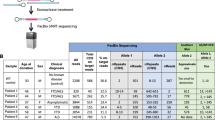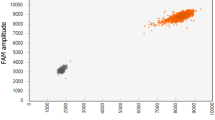Abstract
Expression of human endogenous retroviruses (HERV) has been recurrently observed during cellular differentiation or transformation processes in both cell culture and in vivo. Quantitative approaches that analyze variations in HERV transcription could therefore be valuable for cancer diagnosis. We have developed a quantitative assay combining multiplex degenerate PCR (MD-PCR) and a colorimetric Oligo Sorbent Array (OLISA). Quantification of the expression of these multifamily genes relies on the optimization of the amplification primer mix, that is, the primer degeneracy, the relative concentration of each primer and the total amount of primer. Amplification products of each of the nine studied HERV families are independently and specifically detected and quantified using the OLISA microarray. This method constitutes an improvement over previous pan-retrovirus amplification-based methods, which are mainly qualitative. Furthermore, as MD-PCR/OLISA simultaneously monitors several HERV families, it challenges single-family quantitative RT-PCR. Last, the protocol below provides general rules for the design of MD-PCR applications. Once primers have been designed and optimized, the procedure can be completed in 2 days.
This is a preview of subscription content, access via your institution
Access options
Subscribe to this journal
Receive 12 print issues and online access
$259.00 per year
only $21.58 per issue
Buy this article
- Purchase on SpringerLink
- Instant access to full article PDF
Prices may be subject to local taxes which are calculated during checkout

Similar content being viewed by others
References
Lander, E.S. et al. Initial sequencing and analysis of the human genome. Nature 409, 860–921 (2001).
Belshaw, R., Katzourakis, A., Paces, J., Burt, A. & Tristem, M. High copy number in human endogenous retrovirus families is associated with copying mechanisms in addition to reinfection. Mol. Biol. Evol. 22, 814–817 (2005).
Mallet, F. et al. The endogenous retroviral locus ERVWE1 is a bonafide gene involved in hominoid placental physiology. Proc. Natl. Acad. Sci. USA 101, 1731–1736 (2004).
Antony, J.M. et al. Human endogenous retrovirus glycoprotein-mediated induction of redox reactants causes oligodendrocyte death and demyelination. Nat. Neurosci. 7, 1088–1095 (2004).
Bjerregaard, B., Holck, S., Christensen, I.J. & Larsson, L.I. Syncytin is involved in breast cancer-endothelial cell fusions. Cell Mol. Life Sci. 63, 1906–1911 (2006).
Strick, R. et al. Proliferation and cell-cell fusion of endometrial carcinoma are induced by the human endogenous retroviral Syncytin-1 and regulated by TGF-beta. J. Mol. Med. 85, 23–28 (2007).
Schulte, A.M. et al. Human trophoblast and choriocarcinoma expression of the growth factor pleiotrophin attributable to germ-line insertion of an endogenous retrovirus. Proc. Natl. Acad. Sci. USA 93, 14759–14764 (1996).
Ruda, V.M. et al. Tissue specificity of enhancer and promoter activities of a HERV-K(HML-2) LTR. Virus Res. 104, 11–16 (2004).
Mager, D.L., Hunter, D.G., Schertzer, M. & Freeman, J.D. Endogenous retroviruses provide the primary polyadenylation signal for two new human genes (HHLA2 and HHLA3). Genomics 59, 255–263 (1999).
Forsman, A. et al. Development of broadly targeted human endogenous gammaretroviral pol-based real time PCRs quantitation of RNA expression in human tissues. J. Virol. Methods 129, 16–30 (2005).
Muradrasoli, S., Forsman, A., Hu, L., Blikstad, V. & Blomberg, J. Development of real-time PCRs for detection and quantitation of human MMTV-like (HML) sequences HML expression in human tissues. J. Vivol. Methods 136, 83–92 (2006).
Seifarth, W. et al. Rapid identification of all known retroviral reverse transcriptase sequences with a novel versatile detection assay. AIDS Res. Hum. Retroviruses 16, 721–729 (2000).
Seifarth, W. et al. Assessment of retroviral activity using a universal retrovirus chip. J Virol. Methods 112, 79–91 (2003).
Seifarth, W. et al. Comprehensive analysis of human endogenous retrovirus transcriptional activity in human tissues with a retrovirus-specific microarray. J. Virol. 79, 341–352 (2005).
Pichon, J.P., Bonnaud, B., Cleuziat, P. & Mallet, F. Multiplex degenerate PCR coupled with an oligo sorbent array for human endogenous retrovirus expression profiling. Nucleic Acids Res. 34, e46 (2006).
Mallet, F. Comparison of competitive PCR and positive control based PCR. in Quantitative PCR Protocols. (eds. Kochanowski, B. & Reischl, U.) 103–116 (Humana Press, Totowa, 1999).
Mallet, F. & Prudhomme, S. [Retroviral inheritance in man]. J. Soc. Biol. 198, 399–412 (2004).
Tristem, M. Identification and characterization of novel human endogenous retrovirus families by phylogenetic screening of the human genome mapping project database. J. Virol. 74, 3715–3730 (2000).
Benit, L., Lallemand, J.B., Casella, J.F., Philippe, H. & Heidmann, T. ERV-L elements: a family of endogenous retrovirus-like elements active throughout the evolution of mammals. J. Virol. 73, 3301–3308 (1999).
Bustin, S.A. Quantification of mRNA using real-time reverse transcription PCR (RT-PCR): trends and problems. J. Mol. Endocrinol. 29, 23–39 (2002).
Thompson, J.D., Higgins, D.G. & Gibson, T.J. CLUSTAL W: improving the sensitivity of progressive multiple sequence alignment through sequence weighting, position specific gap penalties and weight matrix choice. Nucleic Acids Res. 22, 4673–4680 (1994).
Galtier, N., Gouy, M. & Gautier, C. SEA VIEW and PHYLO_WIN: two graphic tools for sequence alignment and molecular phylogeny. Comput. Appl. Biosci. 12, 543–548 (1996).
Rozen, S. & Skaletsky, H.J. Primer3 on the WWW for general users and for biologist programmers. in Bioinformatics Methods and Protocols: Methods in Molecular Biology. (eds. Krawetz, S. & Misener, S.) 365–386 (Humana Press, Totowa, 2000).
Acknowledgements
J.-Ph. Pichon was supported by doctoral fellowships from bioMérieux and l'Association Nationale de la Recherche Technique and from l'Association pour la Recherche sur le Cancer.
Author information
Authors and Affiliations
Corresponding author
Ethics declarations
Competing interests
The authors declare no competing financial interests.
Rights and permissions
About this article
Cite this article
Pichon, JP., Bonnaud, B. & Mallet, F. Quantitative multiplex degenerate PCR for human endogenous retrovirus expression profiling. Nat Protoc 1, 2831–2838 (2006). https://doi.org/10.1038/nprot.2006.475
Published:
Issue date:
DOI: https://doi.org/10.1038/nprot.2006.475
This article is cited by
-
Diminished humoral responses against and reduced gene expression levels of human endogenous retrovirus-K (HERV-K) in psoriasis
Journal of Translational Medicine (2014)
-
HERVs in Neuropathogenesis
Journal of Neuroimmune Pharmacology (2010)



